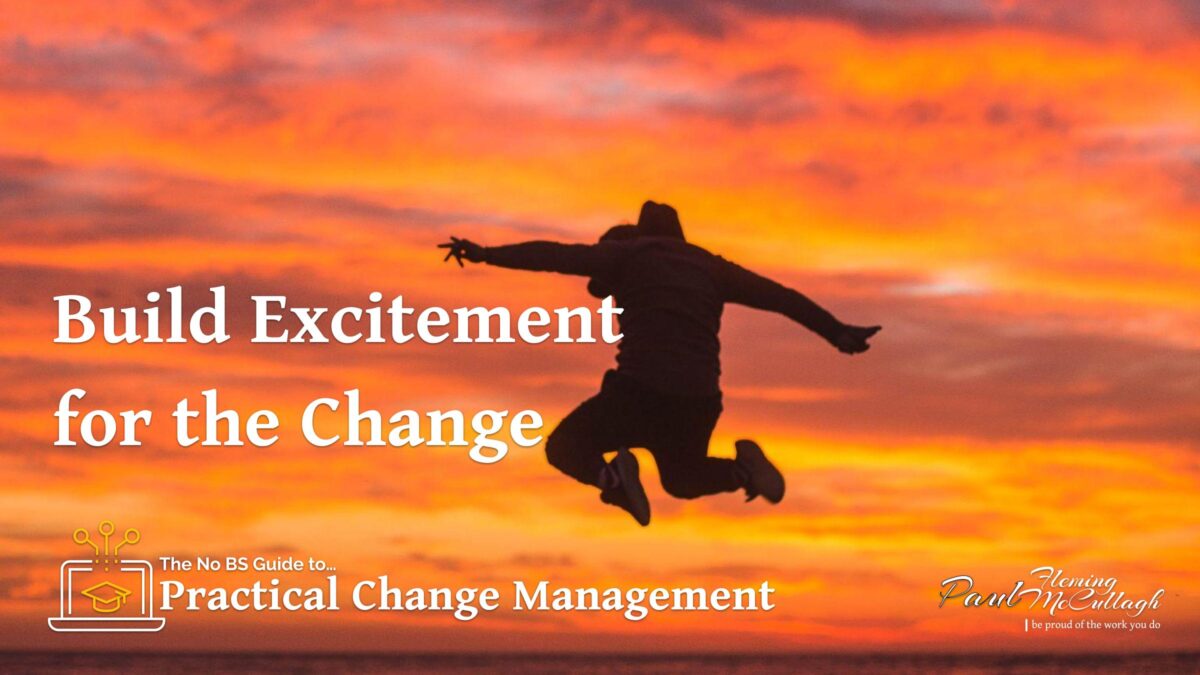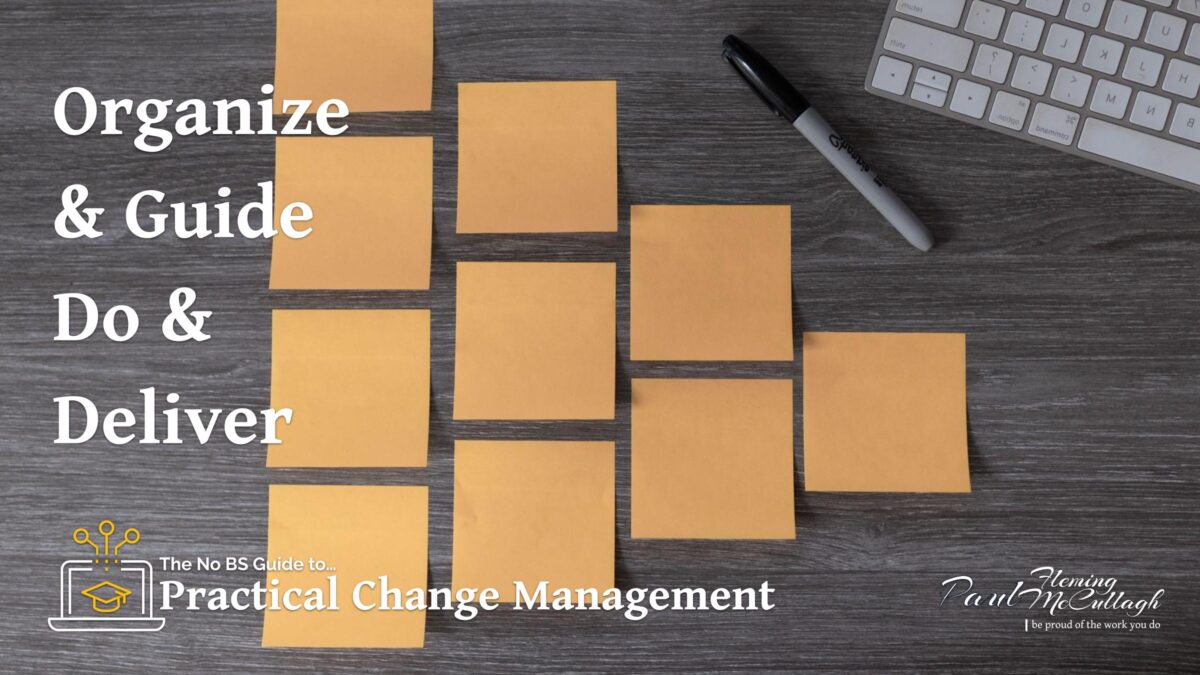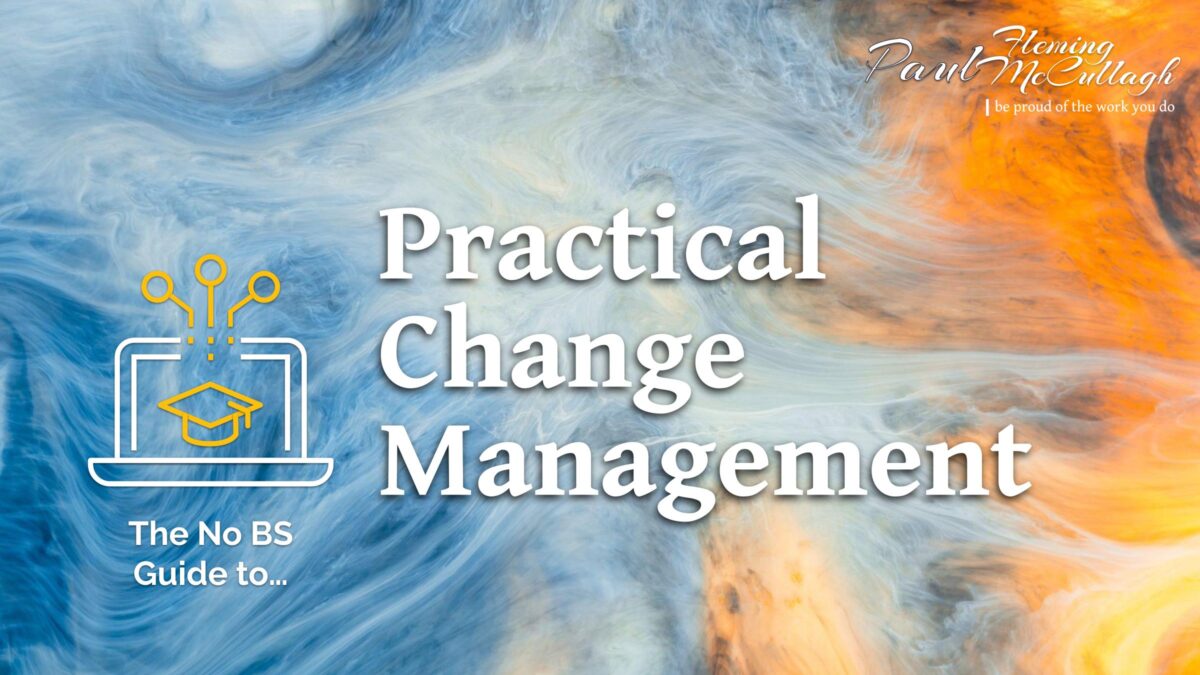Practical Change Management is a fun mix of people, process, and storytelling. What makes it satisfying is the people you are helping, become more confident and better able to do their jobs because of your efforts.
How you get people to their happy place and excited about the change initiative is by providing the right message to the right people at the right time. All very “rrr”.
This No BS Guide to Practical Change Management shares how to get the word out across your organization and encourage buy-in and excitement from the people affected by the change you are promoting.
Practical Change Management Contents
- Responsibilities and Hats
- Build Excitement for the Change
- Create Materials that Tell the Right Story
- Be the Face of Change
- Plan your Change Activities – Organize & Guide, Do & Deliver
- Final Thoughts for Practical Change Management

What You Do on the Project Depends on Which Hat You’re Wearing
To be the most practical change manager in your organization, you need to know what your boss expects from you and how to do it. For example, you’re a change manager who works with Bob, a project manager who’s also known as a change agent. So what do the two of you do and where’s the crossover?
Here’s a quick set of definitions to help:
- A Business Analyst defines the problem and helps provide requirements for the solution.
- The Project Manager leads the successful delivery of the solution and organizes the work the team performs.
- A Change Manager and their team generates excitement and support for the solution.
- The Team Manager develops their team’s strengths and encourages collaboration with other teams.
Underpinning what you do is knowing who you are. Try this: you are someone who is personable, professional, organized, and follows through on their promises.
Now let’s look at how to be the change manager people want to listen to.
Generate Buy-in and Excitement
If we think about ourselves for a moment, we are most comfortable with a new software package, process, or people in the office when we know:
- Why things are changing
- How it’s going to benefit us; and
- What we need to do to get the benefit
We accept the change because we understand what’s going on. For our stakeholders and end-users, it’s the same.
Practical Change Management encourages our stakeholders to be as excited as we are about the change because they support what the change looks like, how they need to adjust, and why it benefits them.

Build Excitement for the Change
To help provide the right message to the right people at the right time, swap shoes with your stakeholders and see things from their perspective. Your goal is to help them become as excited as you are about the project — you are excited, right? — by sharing the reasons that put a smile on your face.
There should be a logical progression in your message. In the beginning, it’s about the impetus for change. Part way through, the focus is on features and benefits, and near the end is training dates and what to do when the change goes into effect.
Along with the temptation to create a one-size fits all communication package, it can also be easy to slip into the habit of sharing incomplete information about a project. Such as only giving a high level view, “they’ll fill in the details themselves“, or providing detailed snippets without sharing the whole, “they’ll build the bigger picture themselves“.
And that’s a problem, because it leads to conjecture, confusion, and concern. The three deadly Cs of change management. The intent may not be malicious, but the result is the same.
Instead, share information that shows the whole and not just individual segments.
When you see the full picture, it’s easier to understand.

Create Materials that Tell the Right Story
The way you provide your message through websites, videos, training manuals, and presentations should encourage participation and confidence in the change. In short, they should be helpful.
But how to tell if your deliverables and events are helpful and encourage engagement?
There are two tests you can run. First, ask yourself these two questions: how can I encourage people and what barriers do I need to remove.
For example:
- How can I encourage people to use the new software, process, or work with the new team at launch?
- How can I encourage continued engagement and use after the launch?
- How can I encourage excitement for the journey between now and launch?
And:
- What barriers do I need to remove so people can do this?
Related: Read Ask the Right Questions for examples and background behind the encourage/barrier questions.
Then, after the encourage/barrier questions, run your deliverables through this engagement checklist. Are your materials:
- Easy to understand and use?
- Do they help fulfill a need?
- Do they get the reader/user’s attention visually or emotionally?

Be the Face of Change
Of all the advice in this post, the following point is the most important and impactful. It can also be the hardest to do.
Be the face of change for your project or organization. Physically talk with people and listen to what they have to say.
Yes, you need to send surveys and offer a generic email address that people can write to when you are dealing with large-scale projects and multiple team members. Absolutely. But you also need to be away from your desk, walking the halls and meeting with departments, managers, executives, and the front-line staff who are most affected by the change.
How often have you wanted to take five minutes and talk with someone, rather than waste an hour hunting for information you can’t find among the countless emails or pages of content on the project website?
Put a human face to the project and go out, or Zoom or Teams chat with people. Talk intelligently, provide clear, easy-to-understand information, and follow through on any promises you make.
When you meet and listen, it can have a big impact on both the project and how your colleagues and stakeholders see you.

Plan your Change Activities – Organize & Guide, Do & Deliver
Now you know what you’re going to say, when, and to whom, the next step is to turn that into a realistic and achievable project plan. You want to take all the great info from your handwritten notes or scattered files on your laptop and turn them into a Plan A and a Plan B — if your communication falls flat and you need to adjust.
The point of the plan is that your team, project sponsor, and executives understand and support what is happening. Why? Because they know what part they play in the communications and what the outcomes are.
With that, the plan should clearly set out:
- The behaviours you want your stakeholders to have tomorrow
- How your stakeholders can transition from what they’re doing today to what they need to do tomorrow
- Why the change will benefit your stakeholders
- Who your stakeholders are so you can provide the right message to the right people at the right time
Now it’s time to add the Project Manager hat to your current headwear and create the overall change plan and execute it. Who on your team creates which collateral? When? Who disseminates the messages among your audience? How do you know your message is making an impact? Is it a positive or negative one?
Related: To help create and execute your plan, take an Organize & Guide, Do & Deliver approach. The article Better Project Management: Organize & Guide, Do & Deliver shows how this technique helps ensure successful outcomes.
Final Thoughts: Practical Change Management – Generate Buy-in & Excitement
Practical change management helps your stakeholders become excited about the change and engage with your activities and communications.
Why? Because when you tell the right story at the right time, you make it clear to everyone, from entry-level to executive:
- How the change benefits the end-user
- What actions people need to take to get the benefits; and
- Why there is excitement for the change
Additional Reading
In North America, two popular models for managing change are Prosci’s ADKAR, and Kotter’s 8-Step Process.
Prosci:
- Awareness of the need to change
- Desire to support the change
- Knowledge of how to change
- Ability to demonstrate skills and behaviours
- Reinforcement to make the change stick
Kotter:
- Create a sense of urgency
- Build a guiding coalition
- Form a strategic vision & initiatives
- Enlist a volunteer army
- Enable action by removing barriers
- Generate short-term wins
- Sustain acceleration
- Institute change




